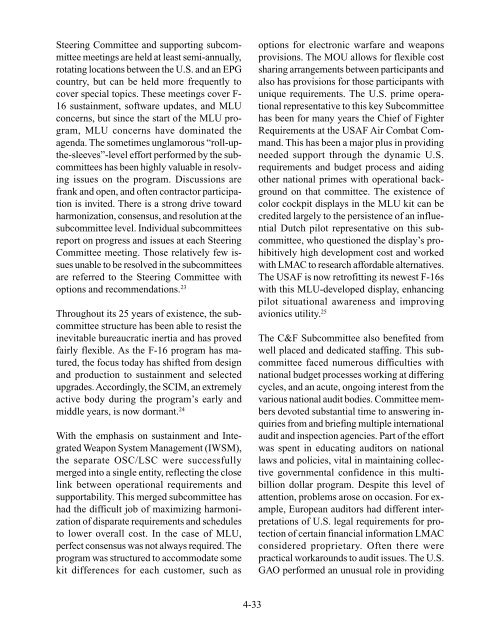Transatlantic Armaments Cooperation - Federation of American ...
Transatlantic Armaments Cooperation - Federation of American ...
Transatlantic Armaments Cooperation - Federation of American ...
Create successful ePaper yourself
Turn your PDF publications into a flip-book with our unique Google optimized e-Paper software.
Steering Committee and supporting subcommittee<br />
meetings are held at least semi-annually,<br />
rotating locations between the U.S. and an EPG<br />
country, but can be held more frequently to<br />
cover special topics. These meetings cover F-<br />
16 sustainment, s<strong>of</strong>tware updates, and MLU<br />
concerns, but since the start <strong>of</strong> the MLU program,<br />
MLU concerns have dominated the<br />
agenda. The sometimes unglamorous “roll-upthe-sleeves”-level<br />
effort performed by the subcommittees<br />
has been highly valuable in resolving<br />
issues on the program. Discussions are<br />
frank and open, and <strong>of</strong>ten contractor participation<br />
is invited. There is a strong drive toward<br />
harmonization, consensus, and resolution at the<br />
subcommittee level. Individual subcommittees<br />
report on progress and issues at each Steering<br />
Committee meeting. Those relatively few issues<br />
unable to be resolved in the subcommittees<br />
are referred to the Steering Committee with<br />
options and recommendations. 23<br />
Throughout its 25 years <strong>of</strong> existence, the subcommittee<br />
structure has been able to resist the<br />
inevitable bureaucratic inertia and has proved<br />
fairly flexible. As the F-16 program has matured,<br />
the focus today has shifted from design<br />
and production to sustainment and selected<br />
upgrades. Accordingly, the SCIM, an extremely<br />
active body during the program’s early and<br />
middle years, is now dormant. 24<br />
With the emphasis on sustainment and Integrated<br />
Weapon System Management (IWSM),<br />
the separate OSC/LSC were successfully<br />
merged into a single entity, reflecting the close<br />
link between operational requirements and<br />
supportability. This merged subcommittee has<br />
had the difficult job <strong>of</strong> maximizing harmonization<br />
<strong>of</strong> disparate requirements and schedules<br />
to lower overall cost. In the case <strong>of</strong> MLU,<br />
perfect consensus was not always required. The<br />
program was structured to accommodate some<br />
kit differences for each customer, such as<br />
4-33<br />
options for electronic warfare and weapons<br />
provisions. The MOU allows for flexible cost<br />
sharing arrangements between participants and<br />
also has provisions for those participants with<br />
unique requirements. The U.S. prime operational<br />
representative to this key Subcommittee<br />
has been for many years the Chief <strong>of</strong> Fighter<br />
Requirements at the USAF Air Combat Command.<br />
This has been a major plus in providing<br />
needed support through the dynamic U.S.<br />
requirements and budget process and aiding<br />
other national primes with operational background<br />
on that committee. The existence <strong>of</strong><br />
color cockpit displays in the MLU kit can be<br />
credited largely to the persistence <strong>of</strong> an influential<br />
Dutch pilot representative on this subcommittee,<br />
who questioned the display’s prohibitively<br />
high development cost and worked<br />
with LMAC to research affordable alternatives.<br />
The USAF is now retr<strong>of</strong>itting its newest F-16s<br />
with this MLU-developed display, enhancing<br />
pilot situational awareness and improving<br />
avionics utility. 25<br />
The C&F Subcommittee also benefited from<br />
well placed and dedicated staffing. This subcommittee<br />
faced numerous difficulties with<br />
national budget processes working at differing<br />
cycles, and an acute, ongoing interest from the<br />
various national audit bodies. Committee members<br />
devoted substantial time to answering inquiries<br />
from and briefing multiple international<br />
audit and inspection agencies. Part <strong>of</strong> the effort<br />
was spent in educating auditors on national<br />
laws and policies, vital in maintaining collective<br />
governmental confidence in this multibillion<br />
dollar program. Despite this level <strong>of</strong><br />
attention, problems arose on occasion. For example,<br />
European auditors had different interpretations<br />
<strong>of</strong> U.S. legal requirements for protection<br />
<strong>of</strong> certain financial information LMAC<br />
considered proprietary. Often there were<br />
practical workarounds to audit issues. The U.S.<br />
GAO performed an unusual role in providing
















